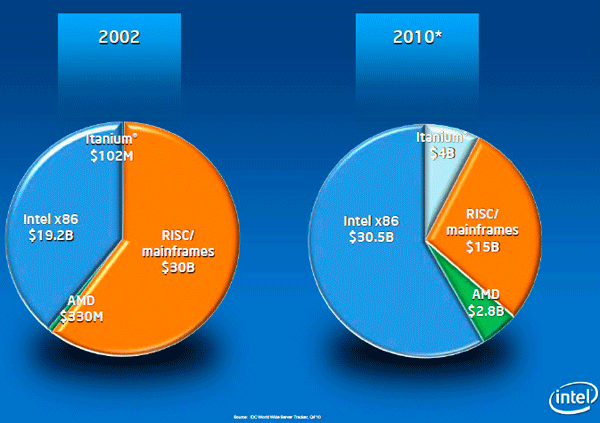Intel Unveils 10-Core Xeons, Mission-Critical Servers
"Intel has been changing the economics for mission-critical computing server deployments for more than a decade, and today we are raising the bar yet again," said Kirk Skaugen, vice president and general manager of Intel's Data Center Group. "The new Intel Xeon processor E7 family delivers record breaking performance with powerful new security, reliability and energy efficiency enhancements. The industry momentum we're seeing for this new server processor architecture is unparalleled in Intel's history. The days of IT organizations being forced to deploy expensive, closed RISC architectures for mission-critical applications are nearing an end."
Intel's presentation made it clear that it's gunning for what's left of the RISC market. Kirk Skaugen, vice president and general manager of Intel's Data Center Group, made a point of telling the conference that there's "No workload in the world today that Xeon can't handle." History certainly favors his words. Intel's quoted figures indicate that while the high end of the server market grew just five percent from 2002-2010, Intel's share of it nearly doubled.
The company went out of its way to note that Itanium's share of the market grew enormously over the past eight years, but it's Xeon, not Poulson, Intel is betting on. The new E7 series incorporates the benefits of Sandy Bridge, its support for new instructions, and its improved power management technology. Intel has also baked in support for low-voltage DIMMs, which allows vendors to opt for 1.35v products. The power savings, at 1W per DIMM, might not sound like much, but the E7 series supports up to 2TB of RAM in a 4S system. According to Intel, low-voltage DDR3 can cut a server's power consumption by up to 128W.

OEM support for the new E7 processors seems downright enthusiastic; 19 vendors have announced a total of 35 systems with shipping to begin immediately. This may be partly due to the way the E7 helps to simplify Intel's product mix. Up to now, Intel's heavy-hitting Beckton was a 45nm chip that lacked the 32nm enhancements of the Xeon 5600 parts.








